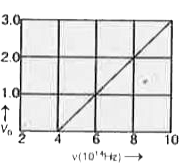The stopping potential V0 in volt as a function of frequency v for a sodium emitter is shown in the figure. The work function of sodium from the data plotted in the figure will be: Given: Planck’s constant h = 6.63 × 10-34 Js electron charges e = 1.6 × 10–19 C1 1.95 eV 2 2.12 eV 3 1.82 eV 4 1.66 eV
Correct option 4 1.66 eVExplanation:
Related Solutions
The stopping potential V_(0) (in volt) as a function of frequency (v) for a sodium emitter, is shown in the figure. The work function of sodium, from the data plotted in the figure, will be: (Given : Planck’s constant) (h) = 6.63 xx10^(-34)Js" electron charge "e=1.6xx10^(-19)C )
View SolutionThe stopping potential (in volt) as a function of frequency (v) for a sodium emitter, is shown in the figure. The work function of sodium, from the data plotted in the figure, will be:
(Given : Planck’s constant)
)
 View Solution
View Solution
the stopping potential (in volt) as a function of frequency (v) for a soidum emitter, is shown in the figure. The work function of sodium from the data plotted in the figure. Will be:
[ given plank's constant , electron charge )View SolutionThe work function of silver and sodium are 4.6 eV and 2.3 eV respectively. What is the ratio of slope of stopping potential versus frequency plot for silver to that of sodium?
View Solutionयहाँ आरेख में एक सोडियम उत्सर्जक के लिए , आवृत्ति के फलन के रूप में, निरोधी विभव (वोल्ट में) के परिवर्तन को दर्शाया गया है। इस ग्राफ से सोडियम का कार्य- फलन प्राप्त होगा (प्लॉंक स्थिरांक इलेक्ट्रॉन आवेश
 View Solution
View Solutionयहाँ आरेख में एक सोडियम-उत्सर्जक के लिए आवृत्ति (v) के फलन के रूप में निरोधी विभव (वोल्ट में) के परिवर्तन को दर्शाया गया है। इस ग्राफ से सोडियम का कार्य-फलन प्राप्त होगा (प्लांक स्थिरांक, Js, इलेक्ट्रॉन आवेश, C)
 View Solution
View SolutionThe photoelectric work function of the emitter of a photocell is 3.63 eV . The frequency of incident light radiation if the stopping potential of the emitter is 3 volt , is
View Solution100 ev The wavelength associated with the energetic electron ray = 3. (h = 6.6 times 10^(-34) Js, 1 Ev = 1.6 times 10^(-19) J, m_(e) = 9.1 times 10^(-31) kg)
View SolutionWhat is the frequency of a photon whose energy 66.3 eV ? Given : h = 6.63 xx 10^(-34) Js
View SolutionFind the maximum velocity of photoelectrons emitted by radiation of frequency Hz from a photoelectric surface having a work function of 4.0 eV. Given Js and 1 eV = J.
View SolutionFind the maximum velocity of photoelectrons emitted by radiation of frequency 3 xx 10^(15) Hz from a photoelectric surface having a work function of 4.0 eV. Given h=6.6 xx 10^(-34) Js and 1 eV = 1.6 xx 10^(-19) J.
View SolutionThe electric field of certain radiation is given by the equation
falls in a metal surface having work function 2.0 eV. The maximum kinetic energy 2.0 eV. The maximum kinetic energy (in eV) of the photoelectrons is [Plank's constant and electron chargeView SolutionWork function of sodium is 2.3 eV. Does sodium show photoelectric emission for orange light ?
GivenView SolutionLight of wavelength falls on a photosensitive metal and a negative potential stops the emitted electrons. The work function of the material ( in eV) is approximately
View SolutionCalculate the threshold frequency for emission of photoelectrons from sodium if its work function is . (Take, Js)
View SolutionThe work function of Silver and sodium are 4.6 and 2.3 eV, respectively . The ratio of the slope of the stopping potential versus frequency plot for silver to that of sodium is
View SolutionThe work function of Silver and sodium are respectively . The ratio of the slope of the stopping potential versus frequency plot for silver to that of sodium is
View SolutionThe work function of Silver and sodium are respectively . The ratio of the slope of the stopping potential versus frequency plot for silver to that of sodium is
View SolutionThe work function of Silver and sodium are respectively . The ratio of the slope of the stopping potential versus frequency plot for silver to that of sodium is
View SolutionLight of frequency Hz falls on a metal surface of work function 2.5 eV. The stopping potential of photoelectrons in volts is
View Solution
